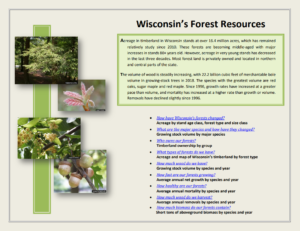Forest Products Specialist Logan Wells will visit with Wisconsin educators at noon on October 8, 2020 on the theme of “Celebrating Wisconsin’s Forest Products.” The webinar, offered by LEAF (Wisconsin’s K-12 Forestry Education Program), is open to anyone but advance registration is required (registration link).
In his presentation, Logan will explore products made from forests in Wisconsin and the importance of markets to sustainable forestry. He will also discuss global marketplace impacts and other changes impacting the industry, how Wisconsin producers are adapting to change, and share information about innovative products on the horizon.
Forest Products Week is the third week of October, so start planning now to showcase how vital forest products are to Wisconsin.

